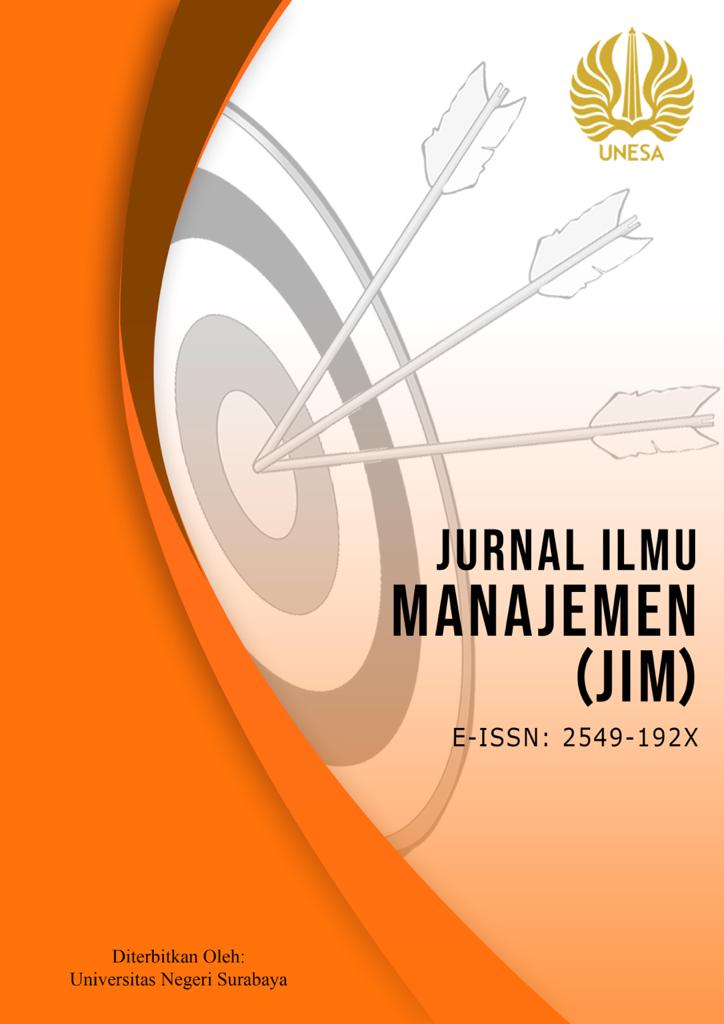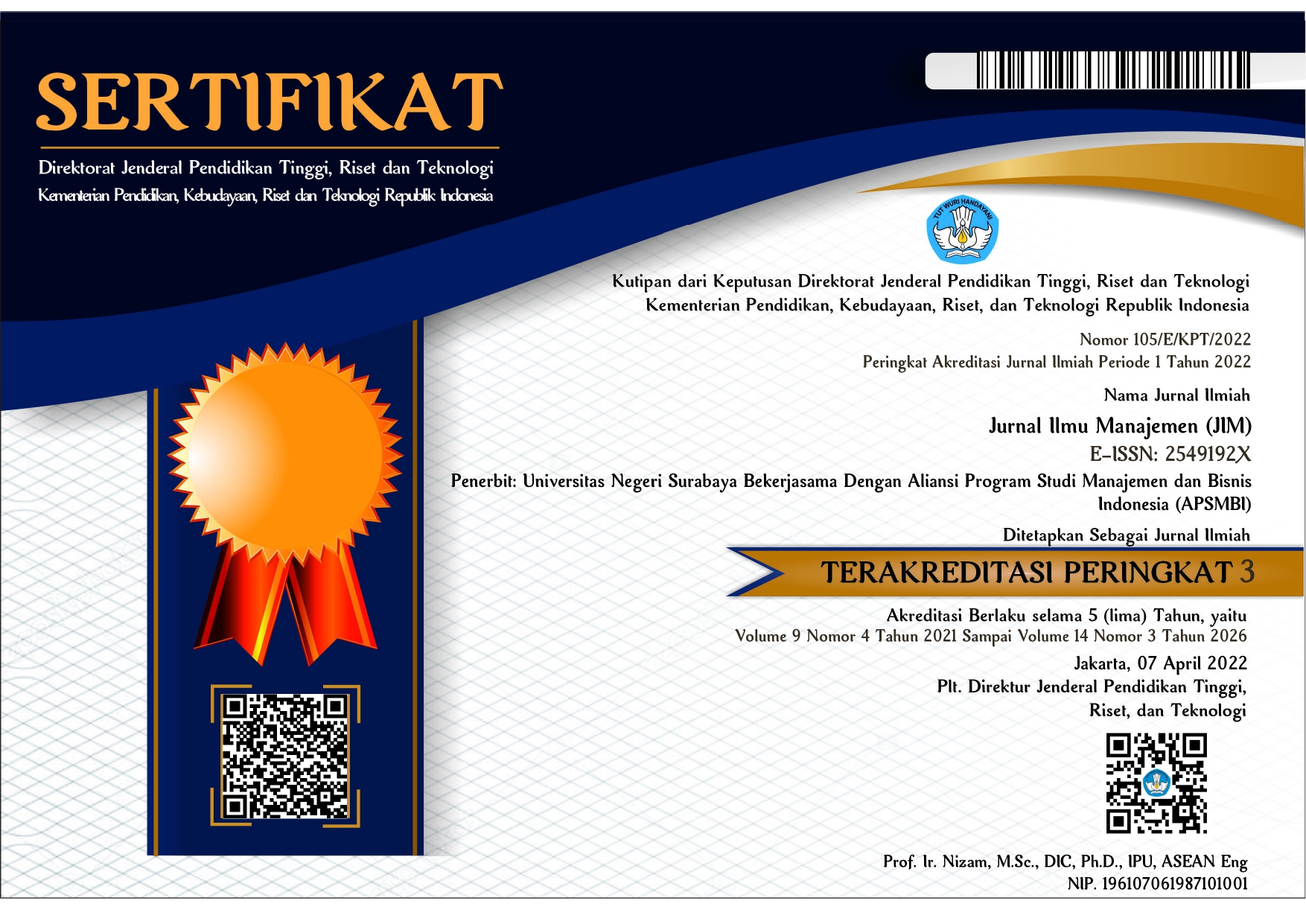Dinamika psikologis konsumen: peran narsisme, fanatisme, kecemburuan terhadap niat pembelian
DOI:
https://doi.org/10.26740/jim.v12n2.p327-338Keywords:
brand fanaticism, brand jealousy, narcissistic behavior, purchase intentionAbstract
In the contemporary digital era, smartphones have transcended their conventional role as mere communication tools, assuming symbolic significance as markers of social status and lifestyle. Among these, the iPhone brand stands out as a symbol of prestige and elegance, marking a distinctive confluence of technological innovation and consumer behavior. This study delves into the multifaceted realm of consumer behavior within the context of iPhone purchases, scrutinizing the interplay of narcissism, brand fanaticism, brand jealousy, and purchase intention. Utilizing data gathered from 155 respondents who participated in iPhone acquisitions through an online questionnaire, the research employed Partial Least Square analysis via SmartPLS version 4 for comprehensive data analysis. The findings illuminate a positive correlation between narcissistic behavior and both brand fanaticism and brand jealousy. Furthermore, brand fanaticism demonstrates a positive influence on purchase intention. However, the analysis indicates no significant impact of the relationship between brand jealousy and narcissistic behavior on purchase intention. This study enriches our understanding of the intricate dynamics shaping consumer purchase intentions, offering valuable insights for the development of targeted marketing strategies tailored to the distinctive characteristics of iPhone consumers.
References
Amalia, E. I. (2016, March 31). Peminat iPhone paling banyak berasal dari Indonesia. https://www.medcom.id/teknologi/news-teknologi/gNQ6QWqb-peminat-iphone-paling-banyak-berasaldari-indonesia
Anello, K., Lannin D. G., & Hermann, A. D. (2019). The values of narcissistic grandiosity and vulnerability. Personality and Individual Differences, 150, Article 109478.
Ayutthaya, P., & Khamwon, A. (2017). Brand love, brand jealousy, and purchase intention of Big Bike Motorcycle. In Proceedings of the Universal Academic Cluster International Summer Conference in Hokkaido.
Chung, E., Farrelly, F., Beverland, M. B., & Karpen, I. O. (2017). Loyalty or liability: Resolving the consumer fanaticism paradox. Marketing Theory, 20(10): 1-28.
Chung, K. H., Yang, K. S., & Kim, U. 2018. Understanding fanaticism: An integrative review. Korean Journal of Social and Personality Psychology, 22(2): 81-100.
Cluley, R., & Dunne, S. (2012). From commodity fetishism to commodity narrcissism. Marketing Theory, 12(3): 251-265.
Cova, B., & Cova, V. (2002). Tribal marketing: The tribalisation of society and its impact on the conduct of marketing. European Journal of Marketing, 36(5/6): 595-620.
De Bellis, E., Sprott, D. E., Herrmann, A., Bierhoff, H. W., & Rohmann, E. (2016). The influence of trait and state narcissism on the uniqueness of mass-customized products. Journal of Retailing, 92(2): 162-172.
Deveci G., & Ercis A. (2017). Determining the influence of fanatical tendencies on consumption styles based on lifestyles. Marketing and Branding Research, 4: 33-49.
Dwi, A., Azkiyah., Elshyfa, I., & Nurwanto, M. (2024). Pengaruh harga, lokasi dan fanatisme terhadap minat pembelian tiket konser blackpink di stadion gelora bung karno. Jurnal Ekonomi, Manajemen, dan Akuntansi, 10(2): 846-859.
Dwidienawati, D., Tjahjana, D., Abdinagoro, S. B., Gandasari, D., dan Munawaroh. (2020). Customer review or influencer endorsement: Which one influences purchase intention more? Heliyon, 6(11), Article e05543.
Ghozali, I., & Latan, H. (2015). Partial least squares konsep teknik dan aplikasi dengan program Smart PLS 3.0 untuk penelitian empiris. Semarang: Universitas Diponegoro Semarang.
Hair, J. F., Sarstedt, M., & Ringle, C. M. (2019). Rethinking some of the rethinking of partial least squares. European journal of marketing, 53(4): 566-584.
Langner, T., Schmidt, J., and Fischer, A. (2015), Is it really love? A comparative investigation of the emotional nature of brand and interpersonal love. Psychology & Marketing, 32(6): 624-634
Lee, S., & Seidle, R. (2012). Narcissists as consumers: The effects of perceived scarcity on processing of product information. Social Behavior and Personality, 40(9): 1485-1500.
Le-Hoang, P. V., Ho, Y. T. T., Luu, D. X., & Le, T. T. T. (2020). Determinants of customer's apartment purchase intention: Is the location dominant? Independent Journal of Management & Production, 11(4): 1303-1322.
McAlexander, J., Kim, S., & Roberts, S. (2003). Loyalty: The influences of satisfaction and brand community integration. Journal of Marketing Theory and Practice, 11(4): 1-11.
Naderi, I., & Paswan, A. K. (2016). Narcissistic consumers in retail settings. Journal of Consumer Marketing, 33(5): 376-386.
Neave, L., Tzemou, E., & Fastoso, F. (2020). Seeking attention versus seeking approval: How conspicuous consumption differs between grandiose and vulnerable narcissists. Psychology & Marketing, 37(3): 418-427.
Ortiz, M. H., Reynolds, K. E., & Franke, G. R. (2013). Measuring consumer devotion: Antecedents and consequences of passionate consumer behavior. Journal of Marketing Theory and Practice, 21(1): 7-30.
Pichler, E., & Hemetsberger, A. (2007). Hopelessly dovetoded to you-towards an extended conceptualization of consumer devotion. Advances in Consumer Research, 34: 194-200.
Redden, J., & Steiner, C.J. (2000). Fanatical consumers: Towards a framework for research. Journal of Consumer Marketing, 17(4): 322-337.
Rose, P. (2007), Mediators of the association between narcissism and compulsive buying: The roles of materialism and impulse control. Psychology of Addictive Behaviors, 21(4): 576.
Sarkar, A., & Sreejesh, S. (2014). Examination of the role played by brand love and jealousy in shaping customer engagement. Journal of Product and Brand Management, 23(1): 24-32.
Somtawinpongsai, C., Abdul H, A. B., Raza, M., Sawangchai, A., & Leonardo C, L. P. (2022). Impact of brand experience, narcissism and materialism on luxury purchase behaviour mediated by online buying intentions. In Management and Information Technology in the Digital Era: Challenges and Perspectives (65-80).
Taylor, D. G., & Strutton, D. (2016). Does Facebook usage lead to conspicuous consumption? The role of envy, narcissism and self-promotion. Journal of Research in Interactive Marketing, 10(3): 231-248.
Thorne, S. (2011). An exploratory investigation of the theorized levels of consumer fanaticism. Qualitative Market Research: An International Journal, 14(2): 160-173
Thorne, S., & Bruner, G. (2006). An exploratory investigation of the characteristics of consumer fanaticism. Qualitative Market Research: An International Journal, 9(1): 51-72.
Turner, A. (2024). How many iPhones have been sold? iPhone shipment and sales statistics in 2024. https://www.bankmycell.com/blog/how-many-iphones-have-been-sold/
Valjakka, T. (2013). The meaning of brand fandom. Journal of Product and Brand Management, 22(5/6): 371-383.
Voyles, B. (2017). Beyond loyalty: Meeting the challenge of customer engagement. The Economist Intelligence Unit. https://graphics.eiu.com/files/ad_pdfs/eiu_AdobeEngagementPt_I_wp.pdf
White, G. L., & Mullen, P. E. (1989). Jealousy: Theory, research, and clinical strategies. New York: Guilford.
Downloads
Published
How to Cite
Issue
Section
License

This work is licensed under a Creative Commons Attribution-NonCommercial 4.0 International License.
 Abstract views: 774
,
Abstract views: 774
, PDF Downloads: 494
PDF Downloads: 494











